Families Raise Awareness of Rare, Underdiagnosed Lung Disease
10.28.2019 | Seattle Children's Press Team
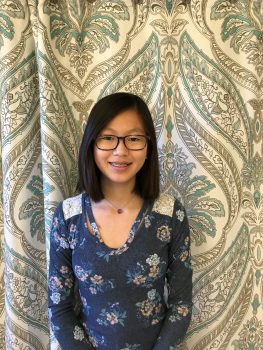 Like a typical 13-year-old, Isabelle Zoerb plays volleyball and tap dances. She also regularly uses an inhaler, takes antibiotics to minimize lung inflammation and wears a therapy vest that vibrates to help clear her lungs. A device in her chest provides intravenous medication when needed.
Like a typical 13-year-old, Isabelle Zoerb plays volleyball and tap dances. She also regularly uses an inhaler, takes antibiotics to minimize lung inflammation and wears a therapy vest that vibrates to help clear her lungs. A device in her chest provides intravenous medication when needed.
This is because Isabelle has primary ciliary dyskinesia (PCD), a rare genetic condition. Cilia are tiny hair-like cells in airways that beat in a coordinated way that clear out germs, mucous and particulates like dust from the respiratory tract. In people with PCD, cilia do not beat properly, which prevents bacteria from clearing the lungs, sinuses, nose and ears.
When Caroline Zoerb adopted Isabelle from China as a toddler, Isabelle’s organs were reversed like a mirror image. She had been born with a hole in her heart and was constantly sick. Seeking answers, the family met Dr. Margaret Rosenfeld, an attending physician and researcher at Seattle Children’s, who thought she might have PCD based on her symptoms.
Seattle Children’s is the only PCD referral center in the Pacific Northwest, with patients coming from Wyoming, Idaho, Oregon, Alaska and Montana. Providers see patients for regular follow-ups to make sure their needs are being met and they are responding to their therapies.
“We always seem to make our way to Seattle Children’s because they have the expertise to help someone with such a rare disease,” Zoerb said.
Speaking up about PCD
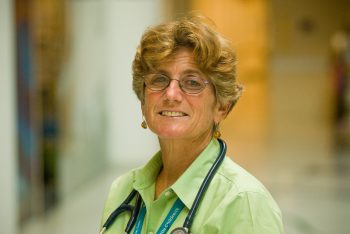 October is the awareness month for PCD, a difficult condition to diagnose. There are a group of symptoms that are commonly seen in people with PCD, but nothing specific. A definitive diagnosis might come from a combination of genetic testing, looking at cilia structure from inside the nose under an electron microscope, and screening for nasal nitric oxide, which is lower in people with PCD.
October is the awareness month for PCD, a difficult condition to diagnose. There are a group of symptoms that are commonly seen in people with PCD, but nothing specific. A definitive diagnosis might come from a combination of genetic testing, looking at cilia structure from inside the nose under an electron microscope, and screening for nasal nitric oxide, which is lower in people with PCD.
Undiagnosed, PCD can lead to damaged airways; repeated sinus, ear and respiratory infections; hearing loss and male infertility.
Isabelle did not have a definitive diagnosis until just recently, when she underwent genetic testing for a research study Seattle Children’s was involved in.
“It made me happy to finally have an official answer,” Isabelle said.
Because the Zoerb family lives on Lopez Island, Rosenfeld collaborates with community doctors to make sure Isabelle receives the best PCD care and is prescribed the correct medication.
“Dr. Rosenfeld deserves a statue or a Doctor of the Year award,” Isabelle said.
Today, in addition to staying active, Isabelle educates people in her community about PCD. She and her volleyball teammates wear orange ribbons and bracelets when they play to raise awareness for the PCD Foundation. Isabelle also passes out bracelets with information about the foundation on them.
“I like to speak up and use my voice to make a difference,” Isabelle said. “I want to spread awareness of PCD because it is a rare, invisible disorder that most people don’t know about.”
Isabelle copes with PCD by reading the Bible and talking to her friends, family, her care team and her counselor.
“Isabelle is an absolute powerhouse,” Rosenfeld said. “She is an active and engaged leader in her community, with great ideas about how she wants to contribute. Her PCD is a severe case, but she pushes right through.”
Isabelle has participated in research at Seattle Children’s to better understand the genetics of PCD as well as the natural history of the disorder.
“I wanted to help people learn more about PCD so they can eventually find a cure or better treatments,” Isabelle said.
Rosenfeld said Seattle Children’s patients are essential to PCD research.
“The patient partnership is so rewarding,” Rosenfeld said. “Thanks to the involvement of these families, we are learning all that we can learn to advance our understanding of PCD.”
The need for better diagnostics, treatment
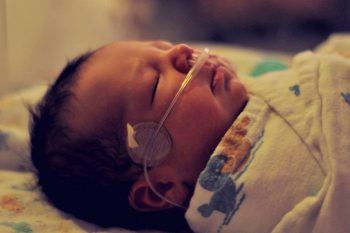 Rosenfeld said parents often go through a “diagnostic odyssey” before their child is diagnosed. Most people with PCD have unexplained neonatal respiratory distress, requiring oxygen or breathing support. They generally develop chronic nasal drainage and chronic wet cough within the first six months of life.
Rosenfeld said parents often go through a “diagnostic odyssey” before their child is diagnosed. Most people with PCD have unexplained neonatal respiratory distress, requiring oxygen or breathing support. They generally develop chronic nasal drainage and chronic wet cough within the first six months of life.
“We hope to increase awareness of PCD, which is highly underdiagnosed, so doctors across different fields can identify children with PCD and help them,” said Dr. BreAnna Kinghorn, a researcher at Seattle Children’s.
Kinghorn has worked with Rosenfeld on research, including a study that compared lung function in children with PCD to children with cystic fibrosis.
“We have identified that children with PCD have lower lung function than they initially realized,” Kinghorn said. “There are sub-groups of people with PCD who have very low lung function and nutrition deficiencies.”
PCD is a progressive disorder, which means it gets worse over time. Treatments include clearing the airway through inhaled therapies, vibrating chest walls to clear mucous, and antibiotics to deal with exacerbations and minimize infection, which could cause lung damage. Many children need ear tubes, regular hearing screening and some need hearing aids. People with PCD might do sinus rinses and some need sinus surgery.
There is currently no standardized care for PCD, which groups like the PCD Foundation are hoping to change.
“The PCD Foundation is a close partner by developing a network of accredited PCD care centers, engaging stakeholders and making sure research aligns with the priorities of people with PCD. They also started a PCD registry,” Rosenfeld said. “They have been an integral part of guiding our research consortium since its inception 15 years ago.”
Family raises funds for PCD research
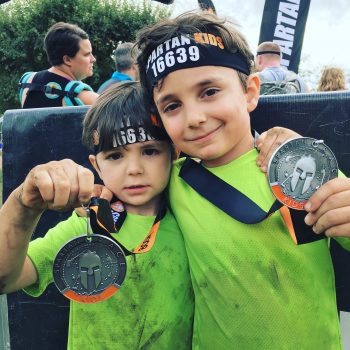 Erin Fox, a parent of a child with PCD, works to raise funds for the foundation through Breathe for PCD. The campaign has raised thousands of dollars through selling T-shirts with PCD-inspired designs, including lungs that represent health and hope.
Erin Fox, a parent of a child with PCD, works to raise funds for the foundation through Breathe for PCD. The campaign has raised thousands of dollars through selling T-shirts with PCD-inspired designs, including lungs that represent health and hope.
“When we learned our baby was born with an extremely rare disease that most people have never even heard of, I just wanted to shout it from the mountaintops,” Fox said. “How can there be a fix to a problem that most people don’t know exists? I wanted to bring awareness to PCD.”
Five years ago, Fox’s son Elliot had difficulty breathing when he was born. After testing him for cystic fibrosis and other conditions, a pulmonologist soon diagnosed him with PCD. Fox said they are lucky Elliot was diagnosed at one month, since many others in the PCD community were undiagnosed or misdiagnosed for years.
Rosenfeld has been seeing Elliot since the family, who now lives in Kennewick, lived in Alaska.
“Elliot is a kind soul who loves to make others around him feel good,” Rosenfeld said. “He’s very creative and a great little artist.”
Elliot recently started kindergarten and is staying healthy. He uses an inhaler to open his airways, a chest therapy vest and sodium chloride medication. Every other month, Elliot takes an inhaled antibiotic for pseudomonas, a chronic infection he has.
“Elliot is doing incredible,” Fox said. “We adore Dr. Rosenfeld and feel like we’re in good hands with her, so we visit her every three months at Seattle Children’s for a check-up.”
Elliot did five 5K runs last year, and the family enjoys hiking together.
“We were told exercise is important for children with PCD, so from a young age, we encouraged Elliot to do as much as he could,” Fox said. “We are always trying to get out and move because it’s beneficial for him. PCD doesn’t slow him down.”
Fox’s passion for PCD awareness is partly driven by the frustration she felt when realizing there was a lack of information about PCD.
“The more people that know about it, the sooner people will get diagnosed, and the more people care, the more research will be done,” Fox said. “The word ‘progressive’ sits heavily on my heart, but we are excited about the advances that researchers have made. We are hoping there will be better therapies and a standard of care in Elliot’s lifetime.”
Advancing knowledge of PCD
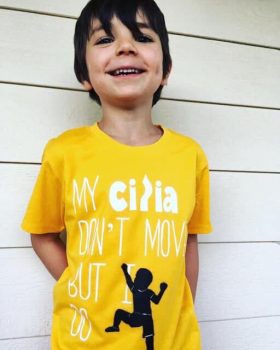 Rosenfeld has been the Seattle Children’s site investigator for the Genetic Disorders of Mucociliary Clearance (GDMCC) Consortium, which is made up of eight clinical research sites in North America.
Rosenfeld has been the Seattle Children’s site investigator for the Genetic Disorders of Mucociliary Clearance (GDMCC) Consortium, which is made up of eight clinical research sites in North America.
The National Heart Lung and Blood Institute recently awarded a $7.5 million grant to the Consortium to continue its research in PCD and other rare lung conditions.
The grant will fund three projects. The first will help diagnose PCD as well as primary immunodeficiencies in patients with certain chronic respiratory symptoms. The second, led by Rosenfeld and Kinghorn alongside University of Colorado researchers, focuses on home monitoring of symptoms and lung function to better understand respiratory illnesses in people with PCD. A third project examines ear and sinus complications.
In the 15 years since its establishment, the consortium has made many contributions to the clinical practice of PCD.
“Together, we have made great advances in our understanding of PCD, including genetics, the appropriate way to diagnose, the natural history and how symptoms change as people get older,” Rosenfeld said. “We are beginning to understand the relationship between PCD’s gene characteristics and observable features, and how certain genetic variants predict the severity of the condition.”
Because of these advances, consortium sites participated in the first multicenter clinical trial in PCD. This is an important step forward for identifying potential therapies for rare respiratory diseases like PCD, according to Rosenfeld.
“We are hoping to make diagnosing PCD more streamlined so that we can hold clinical trials to develop new therapies for people with the condition,” Rosenfeld said. “We are hopeful that more effective therapies for PCD will exist in the future.”